[ad_1]
La Paz County, Arizona
CNN
—
Workers with the water district in Wenden, Arizona, saw something remarkable last year as they slowly lowered a camera into the drought-stricken town’s well: The water was moving.
But the aquifer which sits below the small desert town in the southwestern part of the state is not a river; it’s a massive, underground reservoir which stores water built up over thousands of years. And that water is almost always still.
Gary Saiter, a longtime resident and head of the Wenden Water Improvement District, said the water was moving because it was being pumped rapidly out of the ground by a neighboring well belonging to Al Dahra, a United Arab Emirates-based company farming alfalfa in the Southwest.
Al Dahra did not respond to multiple requests for comment on this story.
“The well guys and I have never seen anything like this before,” Saiter told CNN. The farm was “pumping and it was sucking the water through the aquifer.”
Groundwater is the lifeblood of the rural Southwest, but just as the Colorado River Basin is in crisis, aquifers are rapidly depleting from decades of overuse, worsening drought and rampant agricultural growth.
Residents and farms pull water from the same underground pools, and as the water table declines, the thing determining how long a well lasts is how deeply it was drilled.
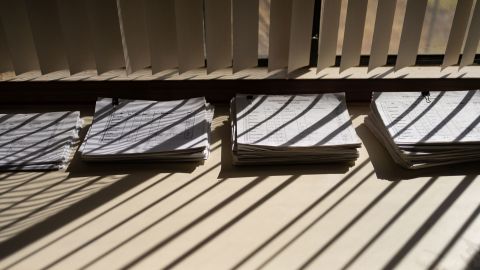
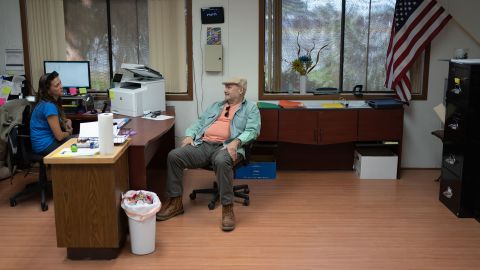
Now frustration is growing in Arizona’s La Paz County, as shallower wells run dry amid the Southwest’s worst drought in 1,200 years. Much of the frustration is pointed at the area’s huge, foreign-owned farms growing thirsty crops like alfalfa, which ultimately get shipped to feed cattle and other livestock overseas.
“You can’t take water and export it out of the state, there’s laws about that,” said Arizona geohydrologist Marvin Glotfelty, a well-drilling expert. “But you can take ‘virtual’ water and export it; alfalfa, cotton, electricity or anything created in part from the use of water.”
Residents and local officials say lax groundwater laws give agriculture the upper hand, allowing farms to pump unlimited water as long as they own or lease the property to drill wells into. In around 80% of the state, Arizona has no laws overseeing how much water corporate megafarms are using, nor is there any way for the state to track it.
But rural communities in La Paz County know the water is disappearing beneath their feet.
Shallow, residential wells in the county started drying up in 2015, local officials say, and deeper municipal well levels have steadily declined. In Salome, local water utility owner Bill Farr told CNN his well – which supplies water to more than 200 customers, including the local schools – is “nearing the end of its useful life.”
And in Wenden, water in the town well has been plummeting. Saiter told CNN the depth-to-water – how deep below the surface the top of the water table is – has dropped from about 100 feet in the late 1950s to about 540 feet in 2022, already far beyond what an average residential well can reach. Saiter is anxious the farms’ rapid water use could push the water table too low for the town well to draw safe water from.
La Paz County supervisor Holly Irwin told CNN getting the state to act on – or even acknowledge – the region’s dwindling water supply has been a “frustrating” yearslong battle which has left her community feeling “forgotten.”
Middle East agriculture companies “have depleted their [water], that’s why they are here,” Irwin said. “That’s what angers people the most. We should be taking care of our own, and we just allow them to come in, purchase property and continue to punch holes in the ground.”
In 2018, Saudi Arabia finalized a ban on growing thirsty crops like alfalfa and hay to feed livestock and cattle. The reason was simple: the arid Middle East – also struggling with climate change-fueled drought – is running out of water, and agriculture is a huge consumer.
But vast dairy operations are a point of national pride in the Middle East, according to Eckart Woertz, director of the Germany-based GIGA Institute for Middle East Studies. So, they needed to find water somewhere else.
“They have all their cows there and they need feeding. That feedstock comes from abroad,” Woertz told CNN.
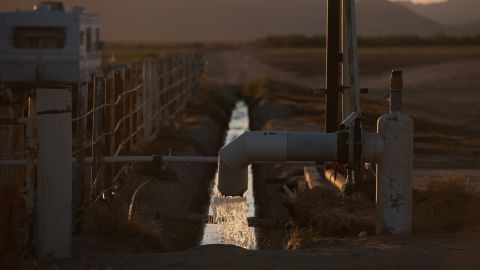
Valued at $14.3 billion, the Almarai Company – which owns about 10,000 acres of farmland in Arizona under its subsidiary, Fondomonte – is one of the biggest players in the Middle East’s dairy supply. The company also owns about 3,500 acres in agriculture-heavy Southern California, according to public land records, where they use Colorado River water to irrigate crops.
Woertz said while most of the company’s cattle feed is purchased on the open market, Alamarai took the extra step of buying farmland abroad, as part of a growing trend in foreign-owned farmland in the US. Foreign-owned farmland in the West increased from around 1.25 million acres in 2010 to nearly three million acres in 2020, according to data from the US Department of Agriculture. In the Midwest, foreign-owned farmland has nearly quadrupled.
“It gives you that sense you’re closer to the source,” Woertz added. “The sense that you own land or lease land somewhere else and have direct bilateral access [to water] gives you a sense of maybe false security.”
In the high desert of Arizona, emerald-green fields stretch for miles alongside dry tumbleweeds and Saguaro cactus.
The Fondomonte-owned Vicksburg Ranch near Salome is massive. The company spent $47.5 million to buy nearly 10,000 acres of land there in 2014, and it leases additional farmland from the state.


Huge storage facilities were erected to hold the harvests. Rows of small houses were built for the farm’s workers, all surrounded by flowering desert shrubs. Tractor trailers filled with bales of alfalfa hay rumble down the highway, which local officials told CNN they had to repair because of the increased agricultural traffic.
The alfalfa on the trucks is eventually shipped to feed cattle in Saudi Arabia.
“They’ve definitely increased production,” Irwin said. “They’ve grown so much since they’ve been here.”
Almarai was transparent about why it wanted the land, according to an article on the purchase from Arab News: The transaction was part of “continuous efforts to improve and secure its supply of the highest quality alfalfa hay from outside the Kingdom to support its dairy business.”
“It is also in line with the Saudi government direction toward conserving local resources,” Arab News added.
Representatives of Fondomonte declined an interview request for this story, but Jordan Rose, the company’s Arizona attorney, provided a statement: “Fondomonte decided to invest in the southwest United States just as hundreds of other agricultural businesses have because of the high-quality soils, and climatic conditions that allow growth of some of the finest quality alfalfa in the world.”
Rose added the farm installed “the most technologically advanced conservation oriented watering systems available on the market.”
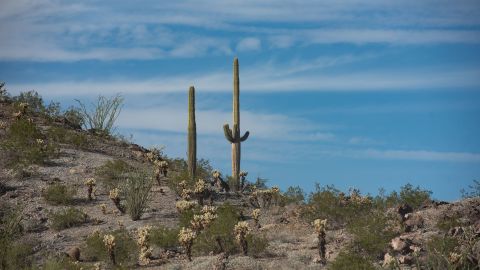
Indeed, there is nothing illegal about foreign-owned farming in the US. And many American farmers use the West’s water to grow crops which are eventually exported around the globe.
But amid the worst drought in centuries, residents and officials have questioned the merit of allowing countries, which themselves are running out of water, unlimited access to a resource as good as gold in the Southwest.
Cynthia Campbell, water resources management adviser for the city of Phoenix, has been watching the La Paz County water situation with frustration.
Phoenix currently gets most of its water from local rivers and the Central Arizona Project, which diverts Colorado River water to Phoenix and Tucson. But it could use rural groundwater as a safety net in the coming years if the city’s primary sources are further restricted.
That is, if there is any groundwater left by then.
“We are literally exporting our economy overseas,” Campbell said. “I’m sorry, but there’s no Saudi Arabian milk coming back to Southern California or Arizona. The value of that agricultural output is not coming through in value to the US.”
Despite the ever-looming water crisis, people are still drawn to small Southwest towns like Wenden and Salome because of the low home prices and the freedom of desert living.
While housing costs in the country rocket upward, rural Arizona has remained a stubbornly affordable place to live. Homes cost between $30,000 and $40,000, and residential taxes paid to the county are below $300 per year, Saiter, the head of Wenden’s water district and a longtime resident, told CNN.
“People are able to afford to live here, versus Phoenix,” Gary’s wife, De Vona Saiter, told CNN. Median incomes in the county are low, “but you can still have a beautiful life.”
The Saiters’ house and rental properties around town – as well as De Vona’s mother Gloria Kaisor’s home down the street – are decorated with hand-drawn art, gardens and antiques.
Kaisor is a longtime resident who first moved to Wenden with her family in the 1960s. After living in Phoenix for years, she gravitated back to the rural area.
“This is home,” Kaisor said. “You don’t hear a noise. It’s quiet. I don’t want to be around a lot of people. You can do whatever you want.”
Yet the impacts of living near a corporate farm are starting to pile up.
Kaisor’s home was inundated with silty, wet mud this summer. Rainfall runoff from a recent monsoon flood carried it from the farm right into Wenden. Gary Saiter believes Al Dahra farm staff have rerouted natural waterways, forcing the rainfall into town rather than out into the desert washes.
Kaisor and her neighbors’ fences are reinforced with sheet metal to try to stop mud and water from coming into their houses, but Kaisor was trapped in her house during a storm earlier this year.
“The whole property was full of mud,” De Vona Saiter said.
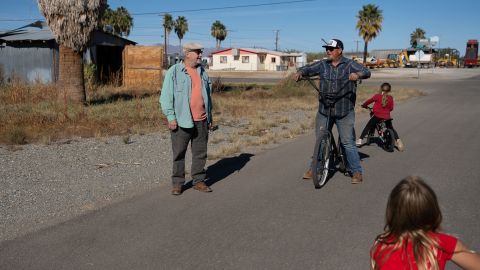
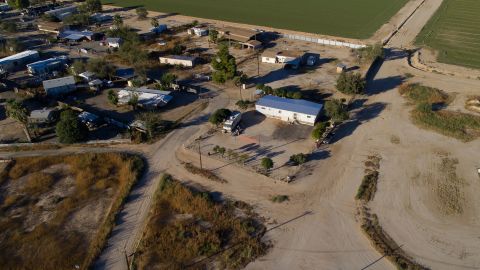
Al Dahra did not respond to CNN’s questions for this story, including questions about its water usage, the uptick in residential flooding and potential rerouting of natural waterways.
The company did provide a statement to the Arizona Republic for a story published in 2019: “Water resources in Arizona must be managed wisely in order to preserve our quality of life and to protect the state’s economic health,” Al Dahra said. “The company is fully committed to Arizona and plans to remain here for the long-term.”
Living near the Al Dahra farm also brings more frequent and alarming drought-related impacts.
When it gets windy, a “dirt wall” of soil and dust whips up from the alfalfa fields, exacerbating the Saiters’ allergies. And most noticeably, the ground is literally sinking as the water below the surface gets pumped out.
The floor in De Vona’s shop has sunk a couple inches, she said, and the ground around one well casing has sunk about a foot; so much the wellhead needed to be cut and resized.
With all of this, Gary Saiter doesn’t care if the farm is owned by a company overseas. The way he sees it, it doesn’t make much of a difference who owns the farm; he just wishes they were better neighbors.
“I am kind of ambivalent about the Saudis,” Saiter said. “You can’t control where people sell stuff, and it’s going to go somewhere.”
“I just don’t like the crops they’re growing and the water they’re pumping,” he added.
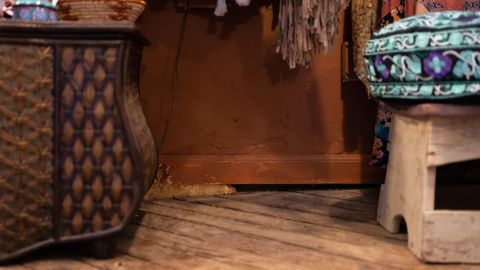
Kari Avila, superintendent and athletics director for Salome High School, believes the farms are providing local economic benefits. Rose, Fondomonte’s Arizona attorney, told CNN in an email the company is the fourth-largest employer in the county.
“They employ a lot of people,” Avila told CNN. “If they weren’t farming it, someone else would be. A lot of people are upset it’s not Americans farming.”
Avila praised the farms for their internship programs and career fairs. Last year, Al Dahra donated an irrigation pump and generator to water Salome’s high school fields, which had been drying up. Avila said the pump installation for the field was fast and took just a few weeks.
But even as the companies are trying to invest in the area, many still question whether those benefits are worth it as water disappears.
“It’s great,” Irwin, the La Paz County supervisor said, “but if you can’t turn your faucet on in five years, that sh*t’s not going to matter.”
The reason some rural residents feel powerless about the fate of their groundwater is because they say Arizona’s state lawmakers have thus far not acted to protect it.
The last time the state passed regulations around groundwater was in 1980, with a law creating certain zones in mostly urban areas, where officials had to ensure they were replenishing underground aquifers and not pumping them dry.
The laws governing the so-called active management areas, or AMAs, are strong compared to groundwater laws in other Southwest states, said Kathleen Ferris, a former top state water official and senior researcher at Arizona State University’s Kyl Center for Water Policy.
But “outside of the AMAs, not so much,” Ferris told CNN.
About 80% of the state falls outside the active management areas, with no restrictions on how much groundwater can be pumped and no way to monitor it.
“It can’t get any worse” than Arizona’s lack of regulation on rural groundwater, Ferris said. “Let’s put it that way.”


Water officials can measure whether water levels in the aquifers are going up or down, but because groundwater is so lightly regulated in rural areas, they don’t have enough data to answer a crucial question: Exactly how much water is left?
“That is one of the challenges of our state; you can’t manage what you don’t measure,” said top Arizona water official Tom Buschatzke, the director of the state’s Department of Water Resources. “We do the best we can with the data and estimated data that we have, but it really begs questions about how much benefit we can really provide.”
As the West’s water crisis grows more intense, groundwater reform has become a flashpoint in this year’s election campaigns.
Arizona attorney general candidate Kris Mayes, a Democrat, has seized on the state’s practice of leasing public land to corporate farms, including more than 6,000 acres leased to Fondomonte, according to the state land department.
A recent investigation by the Arizona Republic found Fondomonte – the second-largest agricultural lessor of Arizona land – is paying the state a heavily discounted rate which does not take their water usage into account.
Mayes said she thinks the leases violate the state constitution and has vowed to cancel them if she’s elected.
“It shouldn’t have happened in the first place,” Mayes told Irwin in September, standing outside Fondomonte’s farm. “We can get these leases canceled, and we should. We are essentially giving our water away for free to a Saudi corporation, and that has to come to an end.”
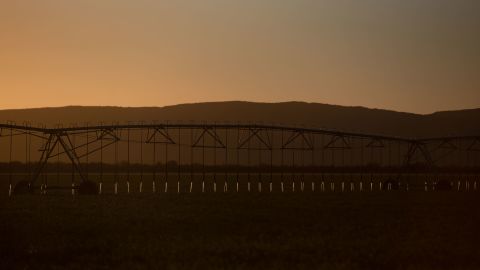
The Arizona State Land Department is studying the state’s water resources in western Arizona, department spokesman Bill Fathauer told CNN. But he added it does not have the authority to implement additional groundwater restrictions.
“The comprehensive data determined from these studies will allow the Department to make an informed decision about not only future land use in these areas but also help determine what the future value of the land is as well,” Fathauer said in an email.
The kind of sweeping water reforms Arizona needs must ultimately come from the state legislature, says outgoing state House member Regina Cobb, a Republican.
For years, Cobb tried to advance bills to allow local officials to regulate their aquifers. The bills never got a committee hearing, Cobb said, never mind making it to the floor for a vote. CNN reached out to Gov. Doug Ducey and top Arizona lawmakers in the state House and Senate for comment; none responded.
As the Colorado River shrinks and Arizona’s share of the water continues to be cut, Cobb told CNN the state’s approach to groundwater has been unthinkable.
“Why are we allowing a foreign company to come into Arizona – which is drought-stricken right now – and have a sweetheart deal [on leases], when we are trying to conserve as much water as we can?” she asked.
“It boggles my mind.”
Read more:
As California’s big cities fail to rein in their water use, rural communities are already tapped out
The West’s historic drought is threatening hydropower at Hoover Dam
Source link



